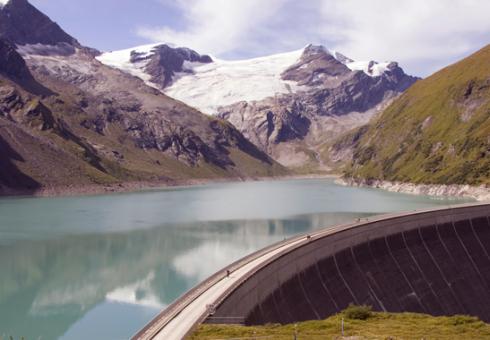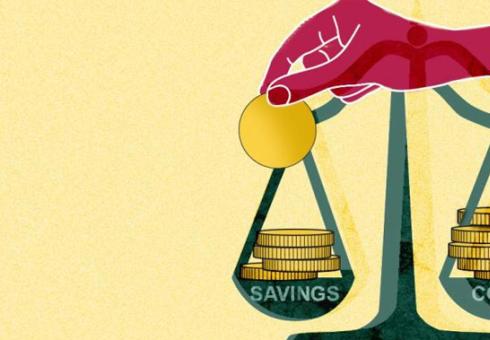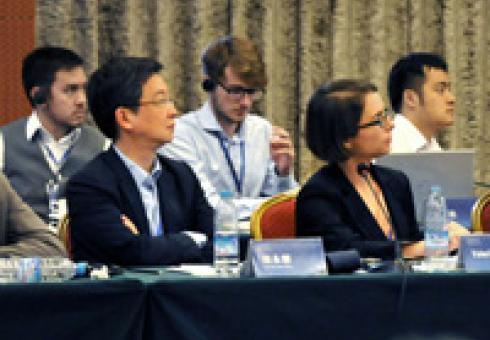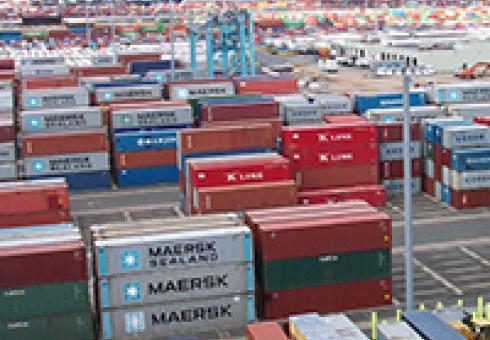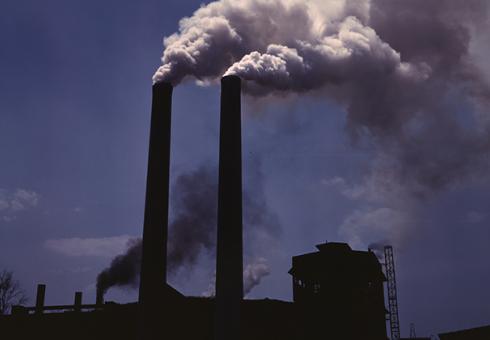News Releases
New committee aims to catalyze community discussion on how MIT can help address climate change.
MIT News Office
On Sept. 19, Maria T. Zuber, MIT’s vice president for research, announced the membership of a community committee to plan and implement the MIT Climate Change Conversation. As Zuber noted, “The Committee should seek broad input from the Institute community on how the US and the world can most effectively address global climate change. The Conversation should explore pathways to effective climate change mitigation, including how the MIT community — through education, research and campus engagement — can constructively move the global and national agendas forward.”
Roman Stocker, an associate professor of civil and environmental engineering and chair of the Committee on the MIT Climate Change Conversation, spoke with MIT News about the committee’s charge, its progress to date, and its next steps.
Q. What does the Committee on the MIT Climate Change Conversation aim to achieve?
A. We aim to explore and assess the broad range of actions that MIT could take to make a significant positive contribution to address climate change. The global nature of this problem and the amount of debate and polarization that surround it are daunting, but the premise of the committee is that the complexity of the problem is uniquely suited for MIT, given our strong problem-solving ethos, and that a leading technical institution can have unique roles to play in responding to the climate crisis. Identifying and evaluating these potential roles is the purpose of the Conversation.
Importantly, the committee will only be the catalyst of the Conversation: Its main actor will be the MIT community! In other words, what we really aim to achieve is the engagement of the widest possible fraction of the MIT community in developing and debating bold ideas — MIT-style! — to help identify the pros and cons of different options. We believe that this approach will allow us, as a community, to identify a broad spectrum of action items; estimate the effectiveness of each action in addressing the problem; and thereby determine how our Institute can most effectively drive forward the national and global agendas on climate change.
We will consider actions at all levels: from new educational initiatives at MIT and via its edX megaphone, to new opportunities for research that capitalize and expand on MIT’s presence in the field, to improvements to campus infrastructure and operations aimed at reducing MIT’s own carbon footprint, to leveraging MIT’s visibility to drive more effective policy. These are but examples, as we do not want to constrain the creativity of the MIT community. We will welcome any and all ideas through the multiple opportunities for input and feedback that we will construct. We look forward to this Conversation as a catalyst for original ideas, debate, and sound analysis.
Q. What has the committee done to date, since its membership was announced on Sept. 19?
A. Devising the right ingredients to make this MIT Conversation successful is what has kept us busy during this first month, and still is. Part of this effort consists of educating ourselves, within the committee, about the landscape of activities that already exist at MIT in the area of climate change, as some of these activities could represent important nucleation sites for bold ideas for action. At the same time, this knowledge will allow us to engage the MIT community in a more informed and meaningful way, through the Conversation activities we have begun to plan for the fall and spring.
Personally, this first month has also allowed me to appreciate the expertise we have on the committee, which I feel will be an invaluable asset in catalyzing this Conversation. The committee is composed of one faculty member per school, as well as representatives from the undergraduate and graduate student bodies, from the postdocs, and from the staff. Collectively, this group encompasses a wide range of expertise, covering both the science and the economics of climate change, as well as the on-campus infrastructural and operational aspects of a university planning for climate change.
The committee is unanimous in its feeling not only of the urgency of the problem — expressed with particular emphasis by the younger generations — but also of the unique opportunity that this Conversation represents for MIT to take on a visible leadership role in the solution of the problem.
Q. How can a member of MIT get engaged in this Conversation?
A. We will create multiple opportunities for engagement throughout the current academic year. In the next few weeks, we will launch both an Idea Bank and a survey. The Idea Bank intends to capture the expertise and creativity of the MIT community and to engage it in a campus-wide brainstorm about what actions MIT could take to address climate change. We will welcome input on the full spectrum of possible actions that MIT could take. We will particularly welcome bold, creative ideas, because we feel that the spectrum of options for action available to a leading technical institution has not been fully explored to date.
The survey is being designed to provide input for the committee in structuring the Conversation. With the survey, we aim to reach a wider fraction of the MIT community — hopefully, all of you! — and to understand how we can best support the community in this important Conversation.
We will carefully review the input we receive through both the Idea Bank and the survey, distill it into broad categories for potential action, and use it to inform the centerpiece of the Conversation, a series of high-profile forums to be held in the spring term. These forums will focus on the different action categories that MIT can consider investing in to further its role in addressing climate change, including education, research, financial actions, policy, campus operations — with specifics that will be refined based on community input. The months ahead will represent a vibrant time to discuss climate-change actions at MIT. We invite everyone in the community to be part of this Conversation!
Alli Gold Roberts
MIT Joint Program on the Science and Policy of Global Change
China is the world’s second largest national economy and its largest exporter. This growth has come at a cost, with energy demands and associated environmental damages on the rise. China is now the world leader in consumer energy use and CO2 emissions. As countries around the globe work to reduce carbon emissions, policymakers are interested in measuring and ultimately reducing emissions associated with the relocation of industry and manufacturing overseas.
In a study released in the March issue of Energy Economics, researchers at Tsinghua University and MIT developed a new model to determine if policy proposals could help reduce carbon emissions associated with goods exported from China. They found that taxes on energy-intensive exports and policies encouraging the Chinese economy to shift from industry to services are ineffective in significantly reducing total CO2 emissions, because the same goods would still be produced elsewhere.
“Developed countries are discussing the possibility of imposing a trade tariff on emissions embodied in imported goods in an effort to prevent the relocation of high-emitting industries overseas and to shore up domestic competitiveness,” says Tianyu Qi, a PhD student at Tsinghua University and the lead author of the study. “It is important to understand how vulnerable the Chinese economy is to such a policy.”
Approximately 22 percent of China’s CO2 emissions are the result of net exports. These emissions are categorized as “trade-embodied” emissions because they are produced as a result of goods and services that are exported.
In their analysis, the researchers considered the impacts of two policies that are similar to measures included in China’s Twelfth Five-Year Plan. The first policy is a tax on energy-intensive exports and the second policy involves incentivizing a shift in China’s economy away from industry and towards services.
“In exploring these policies—both of which are advertised as carbon-reducing strategies—we find that neither would have a significant impact on total global emissions because reduced production in China is partially offset by increased production elsewhere,” says Qi, also a researcher with the MIT-Tsinghua China Energy and Climate Project.
If policymakers want to simply reduce emissions associated with China’s trade, the researchers suggest policies that support economic structural changes.
“A policy that targets the expansion of domestic demand, along with a shift toward services, is more effective at reducing China’s export-embodied CO2 emissions,” says Valerie Karplus, co-author of the study and the director of the Tsinghua-MIT China Energy and Climate Project. “This will in turn reduce China’s exposure to potential tariffs on embodied carbon imposed overseas.”
Karplus explains that such a move is not a long-term solution to reducing CO2 emissions and would ultimately shift production of many industrial products to other nations—shifting emissions along with them.
The researchers also find that the EU, the U.S. and Japan are the largest net recipients of trade-embodied CO2 emissions. In addition, the researchers expected energy-intensive industries such as steel and aluminum production to be responsible for most of the CO2 emissions associated with China’s trade, but instead they found the production of machinery and equipment to be the main culprit.
“This because China exports large volumes of machinery and equipment products, such as refrigerators and televisions, even though commodities such as aluminum and steel are more CO2-intensive than these products,” explains Niven Winchester, an environmental economist in MIT’s Joint Program on the Science and Policy of Global Change and a co-author of the study.
To analyze the impact of policies on CO2 emissions, the MIT-Tsinghua China Energy and Climate Project developed a new model called the China-in-Global Energy Model, or C-GEM. C-GEM disaggregates China’s 30 provinces and details the entire energy system. The model also includes global trade data to measure the interactions between China and the global economy.
The Tsinghua-MIT China Energy and Climate Project is a collaborative effort between the MIT Joint Program on the Science and Policy of Global Change and the Institute for Energy, Environment and Economy at Tsinghua University in Beijing, China. This group is working to analyze the impact of existing and proposed energy and climate policies in China on technology, energy use, the environment and economic welfare.
Alli Gold Roberts
MIT Joint Program on the Science and Policy of Global Change
By the late 1990s, scientists had observed more than two decades of rapid global warming, and expected the warming trend to continue. Instead, despite continuing increases in greenhouse gas emissions, the Earth’s surface temperatures have remained nearly flat for the last 15 years. The International Panel on Climate Change verified this recent warming “hiatus” in its latest report.
Researchers around the globe have been working to understand this puzzle—looking at heat going into the oceans, changes in wind patterns, and other factors to explain why temperatures have stayed nearly stable, while greenhouse gas concentrations have continued to rise. In a study published today in Nature Geoscience, a team of scientists from MIT and elsewhere around the U.S. report that volcanic eruptions have contributed to this recent cooling, and that most climate models have not accurately accounted for the effects of volcanic activity.
“This is the most comprehensive observational evaluation of the role of volcanic activity on climate in the early part of the 21st century,” says co-author Susan Solomon, the Ellen Swallow Richards Professor of Atmospheric Chemistry and Climate Science at MIT. “We assess the contributions of volcanoes on temperatures in the troposphere—the lowest layer of the atmosphere—and find they’ve certainly played some role in keeping the Earth cooler.” 
There are many components of the Earth’s climate system that can increase or decrease the temperature of the globe. For example, while greenhouse gases cause warming, some types of small particles, known as aerosols, cause cooling. When volcanoes erupt explosively enough, they enhance these aerosols—a phenomenon referred to as “volcanic forcing.”
“The recent slowdown in observed surface and tropospheric warming is a fascinating detective story,” says Ben Santer, the lead author of the study and a climate scientist at Lawrence Livermore National Laboratory. “There is not a single culprit, as some scientists have claimed. Multiple factors are implicated. The real scientific challenge is to obtain hard quantitative estimates of the contributions of each of these factors to the so-called slowdown.”
The researchers verified the cooling phenomenon by performing two different statistical tests to determine whether recent volcanic eruptions have cooling effects that can be distinguished from the intrinsic variability of the climate. The team found evidence for significant correlations between volcanic aerosol observations and satellite-based estimates of both tropospheric temperature and sunlight reflected by the particles off the top of the atmosphere.
“What’s exciting in this work was that we could detect the influence of the volcanic aerosols in new ways. Using satellite observations confirmed the fact that the volcanic particles reflected a significant amount of the sun’s energy out to space, and of course losing energy means cooling—and the tropospheric temperatures show that too,” explains Solomon, who is also a researcher with MIT’s Joint Program on the Science and Policy of Global Change. “There are still uncertainties in exactly how big the effects are, so there is more work to do.”
Alan Robock, a professor of environmental sciences at Rutgers University and a leading expert on the impacts of volcanic eruptions on climate, says these findings are an important part of the larger climate picture. “This paper reminds us that there are multiple causes of climate change, both natural and anthropogenic, and that we need to consider all of them when interpreting past climate and predicting future climate.”
“Since none of the standard scenarios for evaluating future global warming include volcanic eruptions,” Robock adds, “this paper will help us quantify the impacts of future large and small eruptions when they happen, and thus better interpret the role of humans in causing climate change.”
This research was led by a team at Lawrence Livermore National Laboratory and builds upon work Solomon conducted in 2011, finding that aerosols in an upper layer of the atmosphere—the stratosphere—are persistently variable and must be included in climate models to accurately depict climate changes.
The research was supported by the U.S. Department of Energy.
Alli Gold Roberts
MIT Joint Program on the Science and Policy of Global Change
Black carbon is one of the most potent air pollutants that contributes to global climate change, and is produced by the incomplete combustion of fossil fuels and forest fires. While scientists have known about the role of black carbon for decades, there’s been limited research to calculate global emissions. Now, MIT and National University of Singapore (NUS) researchers have developed a new method to calculate global black carbon emissions.
In a study published in last week’s Journal of Geophysical Research, the researchers calculated the global total of black carbon emissions at 17 teragrams a year between 2000 and 2005. This result is significantly larger than the majority of global air pollution modeling studies, which employ a bottom-up approach. One such study found humans emitted only 7.5 teragrams of black carbon per year during the same five-year period—less than half the new estimate.
“Our results are the first to produce a global top-down estimation of the emissions of black carbon,” says Chien Wang, a senior research scientist with the Joint Program on the Science and Policy of Global Change and co-author of the study.
The top-down method used by Wang and his co-author Dr. Jason Cohen of NUS relies on gathering data from air measurement stations and satellites to sufficiently cover every region of the globe. In this study, data was collected from 238 different stations. They then compiled this data and used inverse modeling to determine the emissions from each of the major pollution regions.
“Current emissions inventories are mainly obtained by adding up estimates of emissions from ever sector of the economy and the environment to obtain a global estimate. This method creates uncertainty in the projections,” says Wang. “Our method eliminates some of these uncertainties by more accurately factoring in population and economic changes around the globe.”
The differences in the emissions estimates are most apparent in China and Southeast Asia. Wang predicts this is the result of the bottom-up method not capturing the rapid socioeconomic growth that has occurred in this region over the past 15 years.
Black carbon enters the atmosphere as small particles and warms the planet by absorbing heat and reducing the ability of the Earth to reflect light back out to space.
Because black carbon plays a key role in air pollution and global climate change, it is essential for policymakers to have an accurate picture of the severity of the problem.
“This top-down method isn’t perfect and still creates some unknowns in the estimates produced,” Wang says, but he suggests that combining both approaches would potentially improve estimates and further eliminate uncertainty. “We hope this work will open the door to further efforts to better quantify and reduce uncertainty in black carbon emissions estimates.”
More: Reprint 2014-1

